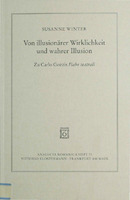Von illusionärer Wirklichkeit und wahrer Illusion
Zu Carlo Gozzis "Fiabe teatrali"
| dc.contributor.author | Winter, Susanne | |
| dc.date.accessioned | 2013-12-31 23:55:55 | |
| dc.date.accessioned | 2019-11-28 14:31:55 | |
| dc.date.accessioned | 2020-04-01T15:16:42Z | |
| dc.date.available | 2020-04-01T15:16:42Z | |
| dc.date.issued | 2007 | |
| dc.identifier | 437139 | |
| dc.identifier | OCN: 608480591 | en_US |
| dc.identifier.uri | http://library.oapen.org/handle/20.500.12657/34442 | |
| dc.description.abstract | In the eighteenth century, Venice was not only a centre of theatre life but also a centre for discussion about theatre. In literary and theatre history the well-known Venetian theatrical dispute, with its protagonists Carlo Goldoni and Carlo Gozzi, seem to provoke a simplistic reproduction of the polemics. A predominantly negative image of Gozzi is correlated with an appreciation of Goldoni and his dramaturgical reform, whrereas while Gozzi is considered the savior of the commedia dell´arte, Goldoni appears as ist grave-digger. This study tries to break open such prejudice, reading Gozzi´s "Fiabe teatrali" as a veritable counterpoint to Goldoni´s comedies and Enlightenment drama. Against the background of Italian theatre in the 18th century and contemporary Venetian theatricality, Gozzi´s intention, as well as the speical caracteristics of his tales for the theatre, becomes evident. Using fairy tales and commedia dell´arte as basic constituents for his "Fiabe teatrali", Gozzi responds to a theatre that emphasizes the reflection of everyday life and follows the concept of utility. The combination of elements are distanced from reality in a way that resembles an ars combinatoria, based on a structure of constrasts that underlines its artificial character. This displays the autonomy of theatrical reality and and the importance of imagination. However, the fairy tale illusion refers back to reality in two ways: on the one hand the traditional masks comment directly current events, on the other hand theatrical illusion indirectly reveals truth that remains secret in discourse. As a new dramatic genre the "Fiabe teatrali" open the possibility to reflect on the constructed character of reality and to set on stage the problematic nature of the perception of truth. | |
| dc.language | German | |
| dc.subject.classification | thema EDItEUR::N History and Archaeology::NH History | en_US |
| dc.subject.other | Carlo Gozzi | |
| dc.subject.other | Italian theatre | |
| dc.subject.other | fairy tales | |
| dc.subject.other | commedia dell´arte | |
| dc.subject.other | illusion | |
| dc.subject.other | Enligthenment | |
| dc.subject.other | Harlekin | |
| dc.subject.other | Märchen | |
| dc.subject.other | Pantalone | |
| dc.subject.other | Polemik | |
| dc.subject.other | Theologische Realenzyklopädie | |
| dc.subject.other | Venedig | |
| dc.title | Von illusionärer Wirklichkeit und wahrer Illusion | |
| dc.title.alternative | Zu Carlo Gozzis "Fiabe teatrali" | |
| dc.type | book | |
| oapen.abstract.otherlanguage | Venedig war im 18. Jahrhundert nicht nur ein Zentrum des Theatergeschehens, sondern zugleich Mittelpunkt lebendiger Theaterdiskussionen. Der sogenannte venezianische Theaterstreit mit den Protagonisten Carlo Goldoni und Carlo Gozzi erscheint in der Literatur- und Theatergeschichtsschreibung vielfach in Form einer vereinfachenden Reproduktion der Polemik. Das überwiegend kritisch-negative Gozzi-Bild korreliert mit einer einseitigen Hochschätzung Goldonis und der von ihm propagierten Theaterreform, wird dagegen Gozzi als Retter der Commedia dell´arte verehrt, gilt Goldoni als ihr Totengräber. Die vorliegende Studie versucht, derartige Vorurteile aufzubrechen und Carlo Gozzis Fiabe teatrali als veritablen Gegenentwurf zu Goldonis Komödien und zum aufklärerischen Drama zu verstehen. Auf dem Hintergrund des italienischen Theaterkontexts im 18. Jahrhundert und der venezianischen Theaterszene der Zeit treten die Besonderheit der Märchenstücke und das Anliegen Gozzis deutlich zutage. Mit den Grundkonstituenten Märchen und Commedia dell´arte wenden sich die Fiabe teatrali gegen ein Theater, das die Wirklichkeitsnähe betont und einen Nützlichkeitsanspruch verfolgt. Die Verbindung der wirklichkeitsfernen Elemente erfolgt in einer Art ars combinatoria, die auf Kontraststrukturen basiert und den artifiziellen Charakter unterstreicht. Damit tritt die Autonomie der theatralen Wirklichkeit hervor, und die Einbildungskraft wird zum entscheidenden Faktor. Das Märchenhafte wird allerdings zweifach an die Erfahrungswirklichkeit rückgebunden: zum einen finden sich in der Maskenrede direkte Verweise auf die nicht-theatrale Wirklichkeit, zum anderen scheinen in der Bühnenillusion Wahrheiten auf, die in der diskursiven Diskussion verborgen bleiben. So eröffnet das neue dramatische Genus der Fiabe teatrali die Möglichkeit, auf den Konstruktcharakter von Wirklichkeit hinzudeuten und die Problematik der Erkenntnis von Wahrheit in Szene zu setzen. | |
| oapen.identifier.doi | 10.26530/oapen_437139 | |
| oapen.relation.isPublishedBy | b801d8ab-75b1-49b4-bf1b-af990841aa85 | |
| oapen.relation.isFundedBy | 26ae1657-c58f-4f1d-a392-585ee75c293e | |
| oapen.relation.isbn | 9783465035091 | |
| oapen.collection | Austrian Science Fund (FWF) | |
| oapen.pages | 358 | |
| oapen.grant.number | D 3817 | |
| oapen.remark.public | Relevant Wikipedia pages: Arte - https://de.wikipedia.org/wiki/Arte; Carlo Goldoni - https://de.wikipedia.org/wiki/Carlo_Goldoni; Carlo Gozzi - https://de.wikipedia.org/wiki/Carlo_Gozzi; Commedia dell’arte - https://de.wikipedia.org/wiki/Commedia_dell%E2%80%99arte; Harlekin - https://de.wikipedia.org/wiki/Harlekin; Märchen - https://de.wikipedia.org/wiki/M%C3%A4rchen; Pantalone - https://de.wikipedia.org/wiki/Pantalone; Polemik - https://de.wikipedia.org/wiki/Polemik; Theologische Realenzyklopädie - https://de.wikipedia.org/wiki/Theologische_Realenzyklop%C3%A4die; Venedig - https://de.wikipedia.org/wiki/Venedig | |
| oapen.identifier.ocn | 608480591 |

